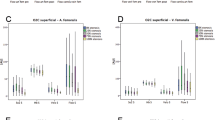Summary
An experimental model was designed for direct, quantitative studies of hemodynamic and morphologic parameters in the microcirculation. It consists of implanting a modified Algire chamber in the dorsal skin flap of hamsters and the implementation of two permanent catheters in jugular vein and carotid artery. The microcirculation was studied using intravital microscopy and television techniques for in situ measurements of blood cell velocity and vascular diameters.
Due to the poor contrast between blood cells, blood capillaries and surrounding s.c. tissue, microvascular beds were visualized using fluorescent microscopy after i.v. injection of 0.2 ml of 5% FITC-Dextran 150. The combination of optical elements and low amounts of FITC-Dextran improved the contrast of the televised image without changing macro- and microhemodynamic parameters, and blood plasma was delineated as bright structure against the substantially darker background of red blood cells and surrounding tissue. This permitted the quantitative study of practically all blood vessels within a given field of s.c. tissue in unanesthetized animals. Blood cell velocity in arterioles was 0.7–1.1 mm/s, 0.2–0.7 mm/s in midcapillaries and reached 0.6 mm/s in collecting venules. Since i.v. injection of drugs and systemic pressure measurements are possible in this model, it provides a unique means for studying the reactivity of the microcirculation over a prolonged period.
Similar content being viewed by others
References
Algire GH (1943) An adaption of the transparent-chamber technique to the mouse. J Natl Cancer Inst 4:1–11
Bagge U, Brånemark RI (1977) White blood cell rheology. Adv Microcirc 7:1–17
Burton KS, Jonson PC (1972) Reactive hyperemia in individual capillaries of skeletal muscle. Am J Physiol 223:517–524
Butti P, Intaglietta M, Reimann H, Hollinger C, Bollinger A, Anliker M (1975) Capillary red blood cell velocity measurements in human nailfold by videodensitometric method. Microvasc Res 10:220–227
Driessen GK, Heidtmann H, Schmid-Schönbein H (1979) Effects of hemodilution and hemoconcentration on red cell velocity in the capillaries of the rat mesentery. Pflügers Arch 380:1–6
Endrich B, Reinhold HS, Gross JF, Intaglietta M (1979) Tissue perfusion inhomogeneity during early tumor growth in rats. J Natl Cancer Inst 62:387–395
Endrich B, Ring J, Intaglietta M (1979) Effects of radiopaque contrast media on the microcirculation of the rabbit omentum. Radiology 132:331–339
Eriksson E, Myrhage R (1972) Microvascular dimensions and blood flow in skeletal muscle. Acta Physiol Scand 86:211–222
Fronek K, Zweifach BW (1977) Microvascular flow in cat tenuissimus muscle. Microvasc Res 14:181–189
Gentry RM, Johnson PC (1972) Reactive hyperemia in arterioles and capillaries of frog skeletal muscle following microocclusion. Circ Res 26:953–965
Goodall CM, Sanders AG, Shubik P (1965) Studies of vascular patterns in living tumors with a transparent chamber inserted in hamster cheek pouch. J Natl Cancer Inst 35:497–521
Intaglietta M, Silverman NR, Tompkins WR (1975) Capillary flow velocity measurements in vivo and in situ by television method. Microvasc Res 10:165–179
Intaglietta M, Tompkins WR (1973) Microvascular measurements by video image shearing and splitting. Microvasc Res 5:309–312
Johnson PC (1971) Red cells separation in the mesenteric capillary network. Am J Physiol 221:99–104
Johnson PC, Burton KS, Henrich H, Henrich U (1976) Effect of occlusion duration an reactive hyperemia in Sartorius muscle capillaries. Am J Physiol 230:715–719
Nims JC, Irwin JW (1973) Chamber technique to study the microvasculature. Microvasc Res 5:105–118
Papenfuss HD, Gross JF, Intaglietta M, Treese FA (1979) A transparent access chamber for the rat dorsal skin fold. Microvasc Res 18:311–318
Prewitt RL, Johnson PC (1976) The effect of oxygen an arteriolar red cell velocity and capillary density in the rat cremaster muscle. Microvasc Res 12:59–70
Rutili G, Arfors KE (1976) Technical Report: Fluorescein-labelled dextran measurement in interstitial fluid in studies of macromolecular permeability. Microvasc Res 12:221–230
Schmid-Schoenbein GW, Zweifach BW (1975) RBC-velocity profiles in arterioles and venules of the rabbit omentum. Microvasc Res 10:153–164
Schoefl GI (1963) Studies on inflammation. III. Growing capillaries: Their structure and permeability. Virchows Arch (Pathol Anat) 337:97–141
Witte S, Goldenberg DM (1967) Microcirculation in tumours and reaction to transplantation. Bibl Anat 9:396–402
Zweifach BW (1974) Quantitative studies of microcirculatory structure and function. I. Analysis of pressure distribution in the terminal vascular bed in cat mesentery. Circ Res 34:843–857
Zweifach BW, Lipowsky H (1977) Quantitative studies of microcirculatory structure and function. III. Microvascular hemodynamics of cat mesentery and rabbit omentum. Circ Res 41:380–390
Author information
Authors and Affiliations
Additional information
Supported by DFG grant EN 114/2
Rights and permissions
About this article
Cite this article
Endrich, B., Asaishi, K., Götz, A. et al. Technical report—a new chamber technique for microvascular studies in unanesthetized hamsters. Res. Exp. Med. 177, 125–134 (1980). https://doi.org/10.1007/BF01851841
Received:
Accepted:
Issue Date:
DOI: https://doi.org/10.1007/BF01851841




